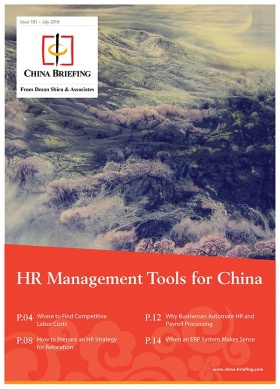Intra-group Service Fee Treatment in China
Most multinational corporations (MNCs) charge their subsidiaries for services like human resources (HR) or information technology support. The subsidiary’s payment for these services is classed as intra-group service fees when they are made within same enterprise group.
Because some businesses use this method to avoid tax and shift profits, tax authorities in China heavily scrutinize intra-group service fees paid by Chinese enterprises to the overseas-related parties. For example, the tax authorities are very likely to conduct special anti-avoidance investigations on transactions when the payment is large or when the recipient is located in low profit jurisdictions.
While smaller- and medium-sized enterprises might presume that they can fly under the radar, transfer pricing professionals across the country can affirm that the tax authorities are paying greater attention to intra-group payments. China-based subsidiaries therefore need to stay up-to-date with relevant rules, regulations, and local practices when entering into special service arrangements with its overseas-related parties.
Revamped regulations
Since 2012, tax authorities have made great efforts to formalize its regulations for intra-group service fees.
- In April 2014, State Administration of Taxation (SAT) submitted a commentary letter, “Views on Intra-group Service Fees and Administration Expenses”, to the UN upon request; the letter illustrated anti-avoidance challenges and introduced “six tests” for evaluating the transfer pricing risks of intra-group service fees.
- In March 2015 , SAT promulgated the “Announcement on Issues Relating to Corporate Income Tax on Expenses Paid by an Enterprise to its Overseas Affiliated Party”(SAT Announcement [2015] 16, Circular 16), stipulating the criteria for outbound payments that cannot be deducted from corporate income tax.
- In March 2017, SAT issued the“Announcement on Promulgation of the Administrative Measures on Special Tax Investigation, Adjustment and Mutual Agreement Procedure” (SAT Announcement [2017] No. 6, Circular 6), which consolidated China’s pre-existing regulations regarding outbound payments and formalized some long- standing practices in China’s transfer pricing
These documents form the regulations for intra-group service fees in the country. Equally, the principles, test methods, and examples contained inside help taxpayers self-assess their transfer pricing positions and prepare for potential challenges from tax authorities.
China’s position on intra-group service fees
China’s position on intra-group services is generally in line with global standards. To ensure profits are taxed where economic activities occur, and where value is created, intra-group outbound charges are only deductible when they comply with the arm’s length principle. However, China has its own understanding as to what constitutes “arm’s length”.
China defines arm’s length intra-group services broadly as beneficial service transactions. More specifically, these beneficial service transactions are priced according to prevailing business practices and fair market rates for transactions conducted between non-related parties under identical or similar circumstances.
Here, professionals should analyze two issues: one, whether the service is beneficial in nature (which is relevant to the authentication of the service provided); two, whether the service is charged under the arm’s length principle (the rationality of the pricing mechanism for the service fee paid).
Beneficial services
In determining whether a service is a beneficial service, China requires that the service bring “direct or indirect economic benefit”to the service recipient. This is in addition to the traditional OECD requirement: the service must be one a non-related party is willing to purchase or implement on its own in comparable circumstances.
In practice, tax authorities in China conduct a beneficial test when investigating the intra-group services. Under this test, authorities conduct six specific tests to determine if the services are beneficial in nature. The six tests include the authenticity test, necessity test, benefits test, value creation test, duplication test, and remuneration test. Any services that fails one of the tests cannot be charged among related parties.
For more clarification, SAT consolidated the “six tests” into Circular 6 and list out the typical non-beneficial services:
- A service that has already been procured or carried out by the enterprise itself;
- A service that is carried out to implement control, management, or supervision of the enterprise and ensure the investment interests of direct or indirect investors, such as:
- Services for shareholders;
- Services relating to formulation and analysis of business reports or financial reports of the direct or indirect investors, the group’s head office, or regional headquarters;
- Fund raising activities related to business and capital operations of the direct or indirect investors, the group’s head office and regional headquarters; and
- Finance, tax, HR, and legal activities implemented for the purpose of the group’s decision-making, supervision, control, or compliance.
- A service that is not specifically carried out for the enterprise though the enterprise has obtained an incidental benefit for being affiliated to the enterprise group, such as:
- Group restructuring activities that integrate resources and scale effect for the recipient;
- Related activities that bring benefits.
- A service that has been compensated for in another related party transaction, such as:
- Services relating to patent or non-patented technologies, which have been compensated from licensing fees;
- Loan-related services that have been compensated from loan interests.
- A service activity that is not relevant to the functions performed or risks assumed by the enterprise, or does not meet the business needs of the service recipient; and,
- Any other services that cannot bring direct or indirect economic benefit to the service recipient, or the service recipient would be unwillingly to pay for it or perform it for
Foreign tax professionals should note that the scope of certain non-beneficial services stipulated above is more expansive than the OECD guidance. This applies in particular to stipulations on shareholder related activities, such as legal activities implemented for group ‘s compliance.
Arm’s length price
If the service passes the beneficial test, the next issue tax professionals need to consider is whether intra-group services are priced on an arm’s length basis. Professionals can evaluate this by comparing the intra-group service fees to those decided by suitable transfer pricing methods.
Among various transfer pricing methods, Circular 6 reiterates that comparable uncontrolled price method (“CUPM”), cost plus method (“CPM”) and transactional net margin method (“TNMM”) are commonly used to analyze the intra-group service price. Professionals should select the method based on the comparability between the tested service and the referential service.
The CUPM would provide the most accurate benchmark of an arm’s length price as it analyzes the actual price of the transactions. In practice, external comparable uncontrolled prices of similar services are often very difficult to obtain because there are no mandatory requirements for companies to disclose the price of the transactions. But if the service provider provides similar services to independent third parties, the internal comparable uncontrolled price can be used.
CPM method determines the arm’s length price by adding a gross profit of comparable unrelated transactions to the cost of related party transactions. Gross mark-up rates are usually based on analysis conducted in the third party transfer pricing database. However, the net margin rates (profits before interest and tax /full costs) can be used as an alternative if there is not adequate gross profit information available.This is the so called TNMM method.
Chinese tax authorities emphasize that the specific characteristics of the services should decide whether the services are comparable or not. The characteristics include the nature of service, technical requirements, professional level, liability borne, payment terms and methods, as well as direct and indirect costs.
For CPM and TNMM, professionals should also analyze other factors that have an impact on profit, such as industry and market information, scale, economic cycle and product life cycle, income, distribution of costs, expenses and assets in various transactions, accounting treatment and business management efficiency, amongst others. Where there are significant differences in the above, enterprise should make an adjustment to account for the impact of the abovementioned differences on the cost-plus rate.
Key takeaways
While China’s position on intra-group service fees are generally in line with the OECD guidelines, China has more stringent requirements on some aspects. Critically, MNCs need to devote additional time to understanding the more expansive scope of shareholder activities. Some tax, HR, and legal activities implemented for the purpose of group’s management and operations may not be regarded as beneficial services in China. Companies are advised to carefully study the relevant rules prior to making the intra-group charges arrangements.
Enterprises with a China presence need to maintain as detailed as possible transaction documents. While this always helps demonstrate the beneficial nature of the intra-group transactions, it is particularly important in China, where current regulations lack clear guidance on the type and extent of required documents that taxpayers should prepare. Detailed documents are also useful when making a cash transfer because of the stringent controls on non-trade foreign exchange payments.
At the very least, the documentation should include the service agreement, service scope and specific service content, cost breakdown of the service (including the manual rate per hour and billable hours), the list of people that provided the services, service location, as well as a service fee receipt voucher.
About Us
China Briefing is produced by Dezan Shira & Associates. The firm assists foreign investors throughout Asia and maintains offices in China, Hong Kong, Indonesia, Singapore, Russia, and Vietnam. Please contact info@dezshira.com or visit our website at www.dezshira.com.
- Previous Article Shijiazhuang to Moscow Freight Express Train Service Commences
- Next Article China-Africa Trade to Benefit from Growing Economic Cooperation

























